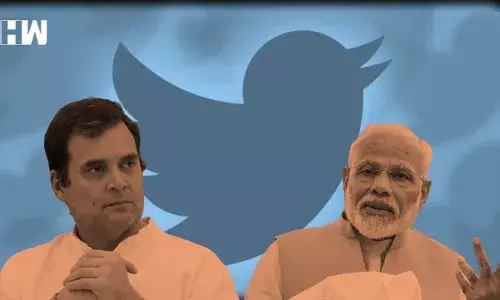New Delhi: Prime Minister Narendra Modi has the highest Twitter followers in India, with 77.8 million, while his most notable opponent, Rahul Gandhi, has only 20.4 million. Despite having nearly quadruple the amount of followers as Modi, Gandhi’s overall Twitter interaction — likes, retweets, and quotes — was roughly three times that of the PM in 2019-21.
These are some of the conclusions of a research report titled “Social Media and Political Leaders: An Exploratory Analysis” by economists Shamika Ravi and Mudit Kapoor, which was released last month by the Delhi-based think tank Observer Research Foundation (ORF).
The article aimed to examine Modi’s and Rahul Gandhi’s Twitter usage, as well as how their audiences react.
During this time, Gandhi averaged 1.7 tweets per day, with 49% of them in Hindi, while Modi averaged about eight tweets per day, with 72% of them in English. Gandhi, on the other hand, sent out more “negative” tweets than Modi, which helped him gain more retweets.
Mudit Kapoor, an associate professor of economics at the Indian Statistical Institute in Delhi, told The Print that the study attempted to understand not only how the two politicians used Twitter for outreach, but also “how social media companies might influence democracy through their algorithms.”
The Analysis Of The Study
The study looked at Modi and Gandhi’s tweets between January 1, 2019 and December 31, 2021, eliminating retweets. It detected “sentiments” expressed in these messages — good, negative, or neutral — the engagement generated by each sort of tweet, as well as the implications of the microblogging site’s new controls ahead of the 2020 US presidential elections, using statistical analysis.
While the analysis indicated that Gandhi’s Twitter involvement was on average higher in 2019-21 — a period of instability marked by criticism of the government’s handling of Covid, the migrant worker problem, and farmer demonstrations — he was also hurt more than Modi by Twitter’s policy change.
It’s also worth recalling that Gandhi said he saw a decline in new followers after his account was temporarily suspended last August for breaking the platform’s rules by publishing photos of a rape victim’s family.
Gandhi also wrote to Twitter CEO Parag Agarwal in December last year, stating that he had been “reliably” informed by employees at Twitter India that “they are under great pressure by the government to quiet my voice,” and that as a result, he had stopped gaining as many followers as usual.
The Congress reported a sense of vindication in March, claiming that Gandhi’s followers had begun to climb after his letter, despite Twitter’s denials.
Rahul Gandhi Has More Engagement On His Tweets- Although, Negative Tweets Get The Most Re Tweets
In total, the two leaders sent out 11,312 tweets in 2019-21, with Gandhi sending out 16% and Modi sending out 84%.
Gandhi, on the other hand, received far more attention for his tweets than Modi. Gandhi’s tweets received 10,034 retweets and 43,455 likes on average, compared to 4,554 and 28,095 for Modi’s.
This may be due, at least in part, to the “feelings” stated by both leaders. The researchers assigned a score to each sentiment, ranging from -1 (the most negative) to + 1 (the most positive) (the most positive). On average, Modi’s tweets were more upbeat than Rahul’s, with a mean emotion score of 0.54 vs 0.09 for Rahul.
While the researchers didn’t go into detail about negative content, it’s clear that Gandhi, as a member of the opposition, had a lot more to criticize and complain about than Modi, especially given the turbulent events of the two years in question, which included two Covid waves and lockdowns, as well as extended farmer protests.
This “bad” content may have aided Gandhi’s tweets in gaining traction. Negative tweets are “more likely to be magnified” than positive ones, according to the authors, especially in terms of retweets.
“If a politician’s goal is to gain attention,then these results indicate that tweets with negative sentiment attract more attention than those with positive sentiment,” the authors wrote.
Twitter Policy Change In 2020 Impacted Rahul Gandhi More Than Modi
Twitter made improvements in October 2020, ahead of the American presidential elections, that were meant to make it more difficult for users to propagate misinformation. These efforts included requiring users to leave a comment before retweeting, displaying warning labels on fraudulent tweets, and removing ‘liked/followed by’ suggestions.
According to the ORF study, this strategy had an impact on Gandhi’s likes, quotes, and retweets, but more so on the Congress leader.
Gandhi’s total engagements fell by 31% on average, from 65,123 to 44,880. Modi’s drop was much more gradual, from 36,354 to 31,533 votes, or nearly 13%.
While Modi’s quotation tweets have climbed by 50%, Gandhi’s have decreased by 38%.
The researchers also looked at how the policy change affected tweets with various emotions.
A tweet with a negative emotion received just around 3% fewer retweets after the policy change for Modi, dropping from an average of 6,010 retweets before the change to 5,808 after it. The drop in retweets for his positive tweets, on the other hand, was far greater, at 24%.
Rahul, on the other hand, saw his negative tweets getting 42 per cent less retweets. His average retweets fell from 11, 829 retweets before the policy change to only 6,823 after it.
In the paper, the researchers noted that “private enterprises” like Twitter were able to “exert an outright large influence on how messages are propagated” as shown by the changes in engagement and amplification of posts, especially negative ones, after the policy change.
In their concluding observations, the study’s authors asked: “Who should control the propagation of political expressions — should it be left to the whims of private enterprises with minimal public oversight, or should they be brought into the ambit of regulation where an explicit code of conduct is established?”
Last year, the government of India was engaged in a tussle with Twitter to hold it legally responsible for content posted on the platform, which also raised a plethora of questions about free speech and democracy.
The following news report’s input is taken from the ORF report titled “Social Media and Political Leaders: An Exploratory Analysis”, along with The Print
As an independent media platform, we do not take advertisements from governments and corporate houses. It is you, our readers, who have supported us on our journey to do honest and unbiased journalism. Please contribute, so that we can continue to do the same in future.

